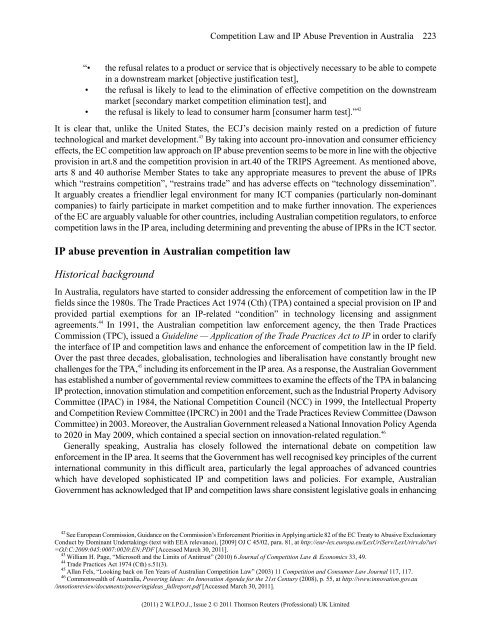WIPO Journal - World Intellectual Property Organization
WIPO Journal - World Intellectual Property Organization
WIPO Journal - World Intellectual Property Organization
You also want an ePaper? Increase the reach of your titles
YUMPU automatically turns print PDFs into web optimized ePapers that Google loves.
“• the refusal relates to a product or service that is objectively necessary to be able to compete<br />
in a downstream market [objective justification test],<br />
• the refusal is likely to lead to the elimination of effective competition on the downstream<br />
market [secondary market competition elimination test], and<br />
• the refusal is likely to lead to consumer harm [consumer harm test].” 42<br />
It is clear that, unlike the United States, the ECJ’s decision mainly rested on a prediction of future<br />
technological and market development. 43 By taking into account pro-innovation and consumer efficiency<br />
effects, the EC competition law approach on IP abuse prevention seems to be more in line with the objective<br />
provision in art.8 and the competition provision in art.40 of the TRIPS Agreement. As mentioned above,<br />
arts 8 and 40 authorise Member States to take any appropriate measures to prevent the abuse of IPRs<br />
which “restrains competition”, “restrains trade” and has adverse effects on “technology dissemination”.<br />
It arguably creates a friendlier legal environment for many ICT companies (particularly non-dominant<br />
companies) to fairly participate in market competition and to make further innovation. The experiences<br />
of the EC are arguably valuable for other countries, including Australian competition regulators, to enforce<br />
competition laws in the IP area, including determining and preventing the abuse of IPRs in the ICT sector.<br />
IP abuse prevention in Australian competition law<br />
Historical background<br />
Competition Law and IP Abuse Prevention in Australia 223<br />
In Australia, regulators have started to consider addressing the enforcement of competition law in the IP<br />
fields since the 1980s. The Trade Practices Act 1974 (Cth) (TPA) contained a special provision on IP and<br />
provided partial exemptions for an IP-related “condition” in technology licensing and assignment<br />
agreements. 44 In 1991, the Australian competition law enforcement agency, the then Trade Practices<br />
Commission (TPC), issued a Guideline — Application of the Trade Practices Act to IP in order to clarify<br />
the interface of IP and competition laws and enhance the enforcement of competition law in the IP field.<br />
Over the past three decades, globalisation, technologies and liberalisation have constantly brought new<br />
challenges for the TPA, 45 including its enforcement in the IP area. As a response, the Australian Government<br />
has established a number of governmental review committees to examine the effects of the TPA in balancing<br />
IP protection, innovation stimulation and competition enforcement, such as the Industrial <strong>Property</strong> Advisory<br />
Committee (IPAC) in 1984, the National Competition Council (NCC) in 1999, the <strong>Intellectual</strong> <strong>Property</strong><br />
and Competition Review Committee (IPCRC) in 2001 and the Trade Practices Review Committee (Dawson<br />
Committee) in 2003. Moreover, the Australian Government released a National Innovation Policy Agenda<br />
to 2020 in May 2009, which contained a special section on innovation-related regulation. 46<br />
Generally speaking, Australia has closely followed the international debate on competition law<br />
enforcement in the IP area. It seems that the Government has well recognised key principles of the current<br />
international community in this difficult area, particularly the legal approaches of advanced countries<br />
which have developed sophisticated IP and competition laws and policies. For example, Australian<br />
Government has acknowledged that IP and competition laws share consistent legislative goals in enhancing<br />
42<br />
See European Commission, Guidance on the Commission’s Enforcement Priorities in Applying article 82 of the EC Treaty to Abusive Exclusionary<br />
Conduct by Dominant Undertakings (text with EEA relevance), [2009] OJ C 45/02, para. 81, at http://eur-lex.europa.eu/LexUriServ/LexUrirv.do?uri<br />
=OJ:C:2009:045:0007:0020:EN:PDF [Accessed March 30, 2011].<br />
43<br />
William H. Page, “Microsoft and the Limits of Antitrust” (2010) 6 <strong>Journal</strong> of Competition Law & Economics 33, 49.<br />
44<br />
Trade Practices Act 1974 (Cth) s.51(3).<br />
45<br />
Allan Fels, “Looking back on Ten Years of Australian Competition Law” (2003) 11 Competition and Consumer Law <strong>Journal</strong> 117, 117.<br />
46<br />
Commonwealth of Australia, Powering Ideas: An Innovation Agenda for the 21st Century (2008), p. 55, at http://www.innovation.gov.au<br />
/innotionreview/documents/poweringideas_fullreport.pdf [Accessed March 30, 2011].<br />
(2011) 2 W.I.P.O.J., Issue 2 © 2011 Thomson Reuters (Professional) UK Limited

















